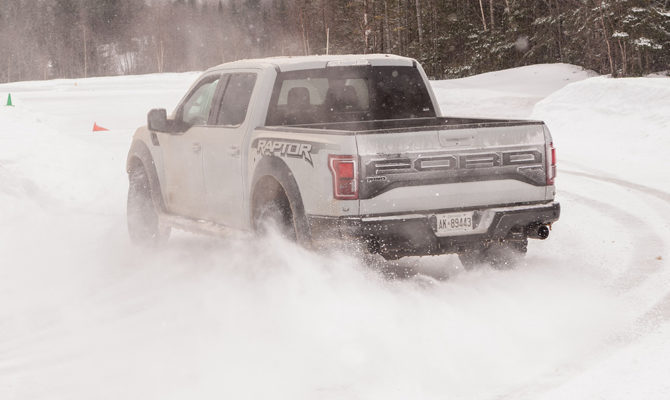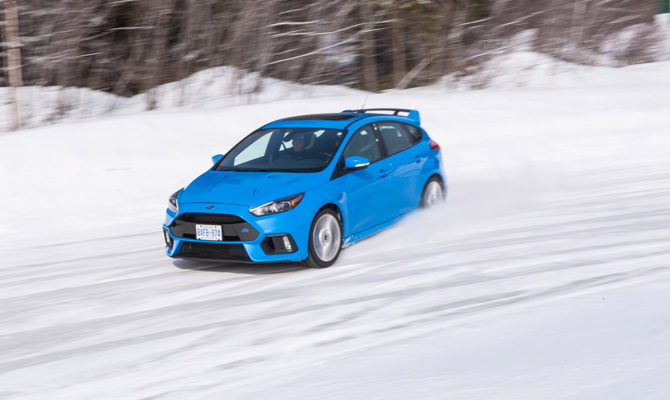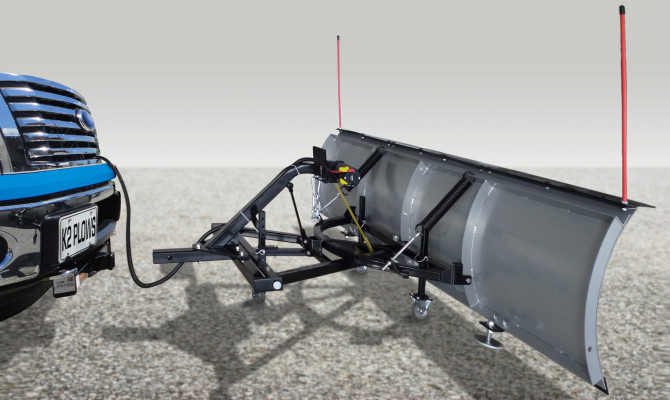(Montreal, QC) I am always down for a winter driving experience, let me tell you – and I don’t just mean what I get from everyday life out here in the Paris of the Prairies, Edmonton, either.
Ford Canada structured an event at the renowned Mecaglisse driving facility here in southern Quebec to show of the capabilities of two of the company’s everyday star performers; the 2017 Raptor and Focus RS
Both the Raptor and Focus RS are the progeny of Ford Performance and both are monsters in their respective class – not just on pavement (or in the Raptor’s intended hunting ground, desert) but wouldn’t you know it, both can handle themselves in Canadian winter.
We had a good day for it, too, though it wasn’t looking that way when I arrived in Montreal the day before the event. Like the rest of the country, Quebec has been getting highly variable weather, and where you could normally expect snow we got a day of rain that threatened to sour the winter driving fun; but luck (depending on your definition of ‘luck’) was with us, as the temperature dropped and new snow appeared overnight – covering a thick layer of ice.
The truck was my favourite, of course; the race-running, rally-ready pickup has always been a bundle of fun since its introduction; and the 2017 Raptor brings a new powerplant and transmission to its widened F150 platform.
A 3.5 litre EcoBoost V6 has replaced the eight-cylinder engine of previous generations, with an (also-new) 10-speed automatic transmission marshalling the 450 horsepower output.
Under the tutelage of professional instructors, sliding the lightened Raptor (the 2017 model has shed 227 kilos from the previous) around and ice-and-water course carved into the woods at Mecaglisse proved to be a great deal of fun; and a showcase for not only the power and handling of the vehicle, but the terrain-mode capabilities as well.
There are six programmed modes a driver can select from – as you might expect, the one called “weather” was demonstrated primarily in this exercise – and coupled with an ever-more robust suspension (the Raptor’s standard ‘Fox Shox’ have been enlarged and the length of travel elongated) and exclusive-to-Raptor BF Goodrich KO2 tires, it is up to any off-road challenge.
Which is not to say that a 2017 Raptor can’t mind its manners on regular roads. Take it to the pavement and it provides a ride as smooth (and a cabin as quiet) as, say, an F150 King Ranch; with a passenger environment every bit as well-appointed, I might add.
Now, while the Raptor is a lot of fun on snow and ice, it can’t match the sporty small-car agility of the Focus, especially when kitted out as the 2017 Focus RS (which Ford also brought a small fleet of to the track).
Running on studded tires for our demonstration, it held firm to the sheet of ice beneath our wheels. With a manual gearbox and standard-equip all-wheel drivetrain (which features a really clever torque-vectoring system, designed to modulate the spin of each wheel when you push the Focus RS hard (especially into the icy corners on the track), the car knows how to rock its exceptional power.
The RS is a more aerodynamic and purposefully-designed beast than the standard Focus (and it is also significantly more expensive, coming in at over 50K after taxes and destination fees), made for deep-pocketed buyers with a need for speed.
The centre piece is the 2.3L turbo four-cylinder engine under the hood – potentially 350 horses and a matching 350 lb.-ft. of torque on tap – bolstered with a couple of selectable drive modes; much like the Raptor but with different intent.
There is Track and Drift mode, the results of which are fairly self-explanatory, and the 2017 RS also gets a Launch Control function, for high power takeoffs from a standing start.
I won’t pretend that I mastered them all, of course, I’m not exactly a professional performance driver, but the best thing about situations like this event is that there are extremely talented driving instructors on hand to show wannabes like myself how it is truly done. Right about the time we of the press start to think that we’re getting the hang of handling the Focus RS on the ice, we switch seats and the instructors take us for a hot lap around the course to show us how professionals do it. Good fun indeed!
Frankly, a day of instruction and hands-on demonstrations at the Mecaglisse facility in Ford’s finest high performers is (almost) enough to make me wish winter would stick around a bit longer.
 When the snow falls, watch out for drivers who couldn’t be bothered to sweep the white stuff from the roof of their car before setting out in the morning.
When the snow falls, watch out for drivers who couldn’t be bothered to sweep the white stuff from the roof of their car before setting out in the morning.
They are a danger to themselves and other road users. When the car heats up that snow generally slides down in a block over their windshield causing one-car white out conditions, long enough for them to collide with you!
What drives-u-crazy?
 The recent snowstorms have brought out the best and the worst in B.C. drivers.
The recent snowstorms have brought out the best and the worst in B.C. drivers.
I would be a millionaire if I had a dollar for every person I’ve watched over-rev a car in a futile bid to escape the combined clutches of snow and ice.
If your car is not shod for the winter weather, then stay home or take a cab. Otherwise, take off slowly in a higher gear than you would in dry weather. You will stand a lot more chance of gaining traction and less reliant on those good people who dig you out! (more…)
For most people who are just using a plow for clearing their own driveway, a straight-blade will more than likely be just fine…
I know I wrote about winter driving last week – and the snow and rain began to fall in various parts of the province – but please don’t blame me for this first blast of chilly weather.
I’m here to help and at the risk of bringing on a blizzard, I thought I would share some information on snow plows.
For most people who are just using a plow for clearing their own driveway, a straight-blade will more than likely be just fine. Snowsport offers a personal plow that is perfect for the homeowner. This system attaches to a front mounted receiver just as a boat trailer would.
The U shaped bracket is connected to the receiver and the snow blade rides up and down on these bars to allow for change in the terrain your plowing. Because there are no hydraulics involved, all you do is back up and the snow blade lies back skimming over the surface.
When driving forward the blade automatically re-engages for plowing. When you are finished, lift the blade back over the push frame into the transport position. The cost of this option is $1,644.
K2 is another brand of snowplow designed for the homeowner with acreage. Designed to work with a front receiver hitch, just like the Snowsport, it simply slides in the receiver and locks in place with a hitch lock. The winch is controlled from inside the cab and will raise or lower the height of the blade. The blade comes with a hardened steel cutting edge scraper, rubber snow deflector, skid shoes, and plow markers. It is available in 82”, 84”, and 88” lengths. Cost is $1,315.
If you use a plow to make money, then you will want to be able to do the job quickly and efficiently, so you may want to go with the multi-position. Multi-position plows are up to 50 percent faster due to the fact that you can reposition the blades to all straight-blade positions in addition to the scoop and V positions. This makes the plow adaptable to nearly any job you need to do.
When it comes to the composition of the blade you have the choice between steel and poly. The vast majority of snowplows on the market today come with steel blades, although the poly plows are becoming more and more popular.
The reason for the growing popularity is that poly is just as strong as steel and maybe stronger. They also have a lower coefficient of friction, which saves on fuel costs and is easier on your vehicle. The poly plows are also saturated with color all the way through so nicks and scratches do not show like they do with steel, plus they do not rust.
Attaching and detaching the plow is very important as well. You do not want to be freezing and trying to deal with getting a blade on and off your truck. Try the attachment system for yourself at the dealer so you can see firsthand how easy or difficult it is to use.
Most snowplow makers use a single halogen light bulb, which are not bright enough; some makers have come out with dual halogen bulbs with the option of upgrading to High Intensity Discharge. These HID lights are four times brighter than standard halogen bulbs and also last ten times as long.
Hydraulics is probably the most important part of the plow, along with the controls. Be sure that the hydraulics system is dependable and the controls are simple and easy to use. Go for quality rather than trying to save a buck. Remember “you get what you pay for” definitely applies here. Cost for these units are $6,000 to $8,000 depending on the model.
When it comes to the warranty, be sure to know exactly what you are getting and what the warranty covers. Some only cover parts, while others cover parts and labor. Warranties are usually either one year or two years; so pay attention to the warranty.
Take all of these things into consideration when shopping for a snowplow and you will be able to choose the right one to suit your needs.
Contact:
Recent Comments
- { Enjoyed your Forest of Bowland in the BMW X5M, particularly the photo of the BMW in front of the main part of Stonyhurst College where... }
- { Bantam designed the Jeep, not Willy's or Ford. The American military gave the original Bantam prototype to Willys and Ford to copy. There is plenty... }
- { All Escalades come with a 6.2-lilter V8 engine that produces 420 horsepower. A six-speed automatic is the only transmission offered and drives the rear wheels.... }
- { Alexandra is an excellent journalist. }
Popular Posts
- Journey to a ‘Sparkling’ Luxury Okanagan Resort “Four lucky readers will put a Dodge Journey’s weekend-...
- The Need For Speed: Hike Those Highway Limits More than half of those polled believe the province sho...
- Drives-U-Crazy… Erratic drivers. An early morning drive from Kelowna to Vancouver is nor...
- Readers Respond: The Pros and Cons of Increasing B.C. Speed Limits Increasing the speed limits will only increase risk to...
- Honda CR-V Review: The Compact Crossover To Get Things Done The CRV is a very stylish and aerodynamic crossover veh...




















